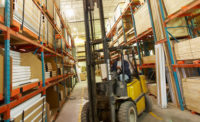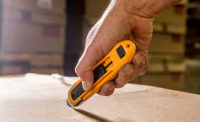When managing a cold storage warehouse, the top priority is keeping the goods within the required temperature range to avoid spoilage that could sicken consumers and upset clients. That’s a crucial aim, but it’s also vital to protect the workers and the building itself. Here are some practical ways to do that.
Educate people on ammonia exposure hazards
Cold chain warehouse facilities often use ammonia-based refrigeration systems. Besides posing a corrosive risk to the lungs, skin, and eyes, ammonia also becomes flammable at an estimated 15% to 28% by volume in air.
The Occupational Safety and Health Administration (OSHA) has numerous ammonia-related standards, including protective clothing and eyewear guidelines. Moreover, employers must alert people to the associated hazards.
In 2019, the U.S Department of Labor and Global Cold Chain Alliance renewed a five-year commitment to work together and teach employees about hazardous chemicals in ammonia refrigeration systems and how to stay safe from them. The effort includes aspects such as process safety and emergency management.
Engage in Warehouse Monitoring
You probably use numerous methods to monitor conditions inside a cold chain warehouse. Taking an all-encompassing approach to employee safety also means investigating how to keep tabs on the outside surroundings, too.
Thermal imaging solutions and wireless sensor networks help managers verify that a facility stays in the proper temperature range. You can also stay abreast of exterior conditions by using security cameras and keeping employee parking lots and loading zones well-lit.
Some facilities also have security guards, especially if decision-makers there worry about warehouse robberies. Cargo theft is a more common threat in some areas, but criminals may decide to take their chances by targeting warehouses instead.
Keep the warehouse protected from the elements
Statistics indicate that the cold chain market’s value could exceed $200 billion by 2023. Thus, as industry demands grow, there’s an ongoing push to build more expansive warehouses to keep pace with client needs.
A warehouse’s size is only part of the picture. The structure also needs adequate protection from the outside. Fabric structure manufacturers offer cover systems that protect a building and its occupants from air and water exposure.
If any building inspection reveals leaks, address those matters promptly. Besides causing potential damage to goods inside, leaks could make the floor slippery, posing a fall risk to workers.
Provide apparel guidance
Warm coats, insulated pants, and thick gloves are standard gear for someone who works in a cold storage warehouse. One excellent way to help employees stay safe is to facilitate getting the apparel they need.
For example, you might provide recommended workwear brands suitable for the environment. Another possibility is to give employees the garments as workplace perks. If that’s not an option, purchasing the products on their behalf and taking the cost out of their earnings makes it easy to check that people have the gear they need. That option also saves them the time of shopping for the items.
Providing clothing for employees does more than keep them safe and comfortable in a demanding environment. It also helps bolster a supply chain’s resilience by increasing productivity and worker engagement. If a person feels well-outfitted for their work, they’ll find it easier to concentrate on tasks and maintain high output. Conversely, consistent discomfort could become a distracting problem.
Stay aware of fire hazards
You may not immediately think of fire as a risk in a cold storage warehouse. However, it’s a realistic possibility, especially since these facilities often hold large quantities of combustible items.
Frozen foods and processed dairy items are common examples of such products. One real-life example concerned a fire in a 60,000-square-foot refrigerated facility used for cheeses. Moreover, the materials used to store and ship such products can also present combustion risks. Cardboard boxes and polystyrene trays are common materials in that category.
Installing sprinkler systems is a good first step. However, safety managers must also regularly test these to ensure they activate when necessary while not causing false alarms.
Besides becoming more aware of fire risks in your cold storage warehouse, remind employees of the proper actions to take if a blaze occurs. Posting reminders around the workplace can remind them to follow best practices in such emergencies.
Request employee feedback
Besides following these building and employee safety suggestions, consider asking workers about specific parts of their work that make them feel unsafe. Could your company provide additional physical resources or training to reduce those perceived threats?
Bear in mind that employees’ specific roles may give them safety insights that are not immediately apparent to you or other people tasked with maintaining a safe working environment. Thus, team feedback could prove exceptionally valuable for covering your bases and minimizing the chances that you overlook a significant issue.
Finally, remember that employee safety concerns may evolve along with your company. Hiring new team members or storing new items could change your current threat level and necessitate new measures. Getting worker feedback during and after those changes helps ensure they’re sufficient.




